|
|
Month
|
Stones - Information from Wikipedia
|
|
January
|
Garnet:-
|
|
|
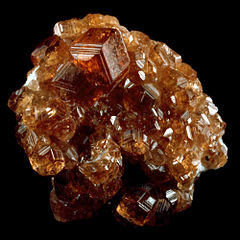 Garnet species are found in many colours including red, orange, yellow, green, purple, brown, blue, black, pink and colourless. The rarest of these is the blue garnet, discovered in the late 1990s in Bekily Madagascar. It is also found in parts of the United States, Russia, Kenya, Tanzania, and Turkey. It changes colour from blue-green in the daylight to purple in incandescent light, as a result of the relatively high amounts of vanadium (about 1 wt.% V2O3). Other varieties of colour-changing garnets exist. In daylight, their colour ranges from shades of green, beige, brown, grey, and blue, but in incandescent light, they appear a reddish or purplish/pink colour. Because of their colour-changing quality, this kind of garnet is often mistaken for Alexandrite. Garnet species' light transmission properties can range from the gemstone-quality transparent specimens to the opaque varieties used for industrial purposes as abrasives. The mineral's luster is categorised as vitreous (glass-like) or resinous (amber-like). Garnet species are found in many colours including red, orange, yellow, green, purple, brown, blue, black, pink and colourless. The rarest of these is the blue garnet, discovered in the late 1990s in Bekily Madagascar. It is also found in parts of the United States, Russia, Kenya, Tanzania, and Turkey. It changes colour from blue-green in the daylight to purple in incandescent light, as a result of the relatively high amounts of vanadium (about 1 wt.% V2O3). Other varieties of colour-changing garnets exist. In daylight, their colour ranges from shades of green, beige, brown, grey, and blue, but in incandescent light, they appear a reddish or purplish/pink colour. Because of their colour-changing quality, this kind of garnet is often mistaken for Alexandrite. Garnet species' light transmission properties can range from the gemstone-quality transparent specimens to the opaque varieties used for industrial purposes as abrasives. The mineral's luster is categorised as vitreous (glass-like) or resinous (amber-like).
|
|
|
|
|
February
|
Amethyst:-
|
|
|
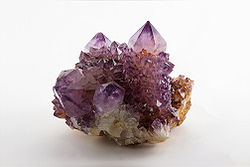 Amethyst is a purple variety of quartz (SiO2) and owes its violet colour to irradiation, iron impurities (in some cases in conjunction with transition element impurities), and the presence of trace elements, which result in complex crystal lattice substitutions. The hardness of the mineral is the same as quartz, thus it is suitable for use in jewellery. Amethyst occurs in primary hues from a light pinkish violet to a deep purple. Amethyst may exhibit one or both secondary hues, red and blue. The best varieties of Amethysts can be found in Siberia, Sri Lanka, Brazil and the far East. The Greeks believed amethyst gems could prevent intoxication, while medieval European soldiers wore amethyst amulets as protection in battle in the belief that amethysts heal people and keep them cool-headed. Beads of amethyst have been found in Anglo-Saxon graves in England. Amethyst is a purple variety of quartz (SiO2) and owes its violet colour to irradiation, iron impurities (in some cases in conjunction with transition element impurities), and the presence of trace elements, which result in complex crystal lattice substitutions. The hardness of the mineral is the same as quartz, thus it is suitable for use in jewellery. Amethyst occurs in primary hues from a light pinkish violet to a deep purple. Amethyst may exhibit one or both secondary hues, red and blue. The best varieties of Amethysts can be found in Siberia, Sri Lanka, Brazil and the far East. The Greeks believed amethyst gems could prevent intoxication, while medieval European soldiers wore amethyst amulets as protection in battle in the belief that amethysts heal people and keep them cool-headed. Beads of amethyst have been found in Anglo-Saxon graves in England.
|
|
|
|
|
March
|
Aquamarine:-
|
|
|
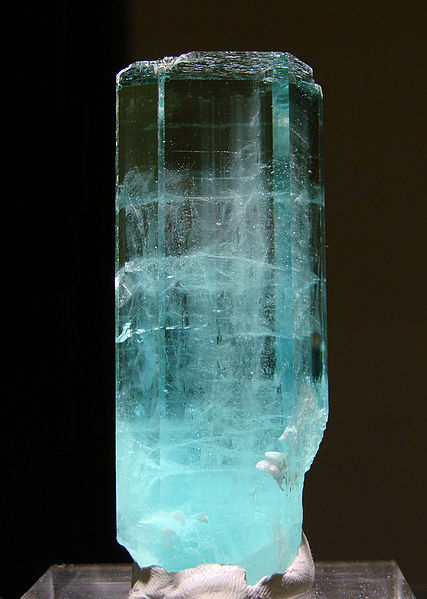 Aquamarine (from Latin: aqua marina, "water of the sea") is a blue or turquoise variety of beryl. It occurs at most localities which yield ordinary beryl. The gem-gravel placer deposits of Sri Lanka contain aquamarine. Clear yellow beryl, such as that occurring in Brazil, is sometimes called aquamarine chrysolite. The deep blue version of aquamarine is called maxixe. Maxixe is commonly found in the country of Madagascar. Its colour fades to white when exposed to sunlight or is subjected to heat treatment, though the colour returns with irradiation. In the United States, aquamarines can be found at the summit of Mt. Antero in the Sawatch Range in central Colorado. In Wyoming, aquamarine has been discovered in the Big Horn Mountains, near Powder River Pass. In Brazil, there are mines in the states of Minas Gerais, Esp≠rito Santo, and Bahia, and small deposits in Rio Grande do Norte. The mines of Colombia, Zambia, Madagascar, Malawi, Tanzania and Kenya also produce aquamarine. Aquamarine (from Latin: aqua marina, "water of the sea") is a blue or turquoise variety of beryl. It occurs at most localities which yield ordinary beryl. The gem-gravel placer deposits of Sri Lanka contain aquamarine. Clear yellow beryl, such as that occurring in Brazil, is sometimes called aquamarine chrysolite. The deep blue version of aquamarine is called maxixe. Maxixe is commonly found in the country of Madagascar. Its colour fades to white when exposed to sunlight or is subjected to heat treatment, though the colour returns with irradiation. In the United States, aquamarines can be found at the summit of Mt. Antero in the Sawatch Range in central Colorado. In Wyoming, aquamarine has been discovered in the Big Horn Mountains, near Powder River Pass. In Brazil, there are mines in the states of Minas Gerais, Esp≠rito Santo, and Bahia, and small deposits in Rio Grande do Norte. The mines of Colombia, Zambia, Madagascar, Malawi, Tanzania and Kenya also produce aquamarine.
|
|
|
|
|
|
Heliotrope (Bloodstone):-
|
|
|
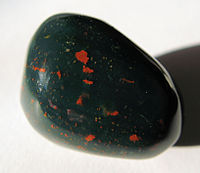 The mineral heliotrope, also known as bloodstone, is a form of chalcedony (which is a cryptocrystalline mixture of quartz and its monoclinic polymorphmoganite). The "classic" bloodstone is green chalcedony with red inclusions of iron oxide or red jasper. Sometimes the inclusions are yellow, in which case the mineral is given the name plasma. The red inclusions are supposed to resemble spots of blood; hence the name "bloodstone". The name "heliotrope" derives from various ancient notions about the manner in which the mineral reflects light. The primary source of the stone is India. It is also found in Brazil, China, Australia and the United States. There is also an outcrop of bloodstone on the Isle of Rum, in Scotland. Heliotrope as raw material and as artefacts from the Chalcolithic sites (5th millennium BC) has been found in the Eastern Rhodopes of Bulgaria. The mineral heliotrope, also known as bloodstone, is a form of chalcedony (which is a cryptocrystalline mixture of quartz and its monoclinic polymorphmoganite). The "classic" bloodstone is green chalcedony with red inclusions of iron oxide or red jasper. Sometimes the inclusions are yellow, in which case the mineral is given the name plasma. The red inclusions are supposed to resemble spots of blood; hence the name "bloodstone". The name "heliotrope" derives from various ancient notions about the manner in which the mineral reflects light. The primary source of the stone is India. It is also found in Brazil, China, Australia and the United States. There is also an outcrop of bloodstone on the Isle of Rum, in Scotland. Heliotrope as raw material and as artefacts from the Chalcolithic sites (5th millennium BC) has been found in the Eastern Rhodopes of Bulgaria.
|
|
|
|
|
April
|
Diamond:-
|
|
|
 In mineralogy, diamond (from the ancient Greek adamas "unbreakable") is a metastable allotrope of carbon, where the carbon atoms are arranged in a variation of the face centred cubic crystal structure called a diamond lattice. Diamond is less stable than graphite, but the conversion rate from diamond to graphite is negligible at standard conditions. Diamond is renowned as a material with superlative physical qualities, most of which originate from the strong covalent bonding between its atoms. In particular, diamond has the highest hardness and thermal conductivity of any bulk material. Those properties determine the major industrial application of diamond in cutting and polishing tools and the scientific applications in diamond knives and diamond anvil cells. Diamonds have been known in India for at least 3,000 years but most likely 6000 years. Diamonds have been treasured as gemstones since their use as religious icons in ancient India. Their usage in engraving tools also dates to early human history. The popularity of diamonds has risen since the 19th century because of increased supply, improved cutting and polishing techniques, growth in the world economy, and innovative and successful advertising campaigns. The most familiar use of diamonds today is as gemstones used for jewellery, a use which dates back into antiquity. The dispersion of white light into spectral colours is the primary geological characteristic of gem diamonds. In the 20th century, experts in gemmology have developed methods of grading diamonds and other gemstones based on the characteristics most important to their value as a gem. Four characteristics, known informally as the four Cs, are now commonly used as the basic descriptors of diamonds: these are carat, cut, colour, and clarity. A large, flawless diamond is known as a paragon. Diamond-bearing rock is carried from the mantle to the Earth's surface by deep-origin volcanic eruptions. Once diamonds have been transported to the surface by magma in a volcanic pipe, they may erode out and be distributed over a large area. A volcanic pipe containing diamonds is known as a primary source of diamonds. Secondary sources of diamonds include all areas where a significant number of diamonds have been eroded out of their kimberlite or lamproite matrix, and accumulated because of water or wind action. These include alluvial deposits and deposits along existing and ancient shorelines, where loose diamonds tend to accumulate because of their size and density. Diamonds have also rarely been found in deposits left behind by glaciers (notably in Wisconsin and Indiana); in contrast to alluvial deposits, glacial deposits are minor and are therefore not viable commercial sources of diamond. Roughly 49% of diamonds originate from Central and Southern Africa, although significant sources of the mineral have been discovered in Canada, India, Russia, Brazil, and Australia. In mineralogy, diamond (from the ancient Greek adamas "unbreakable") is a metastable allotrope of carbon, where the carbon atoms are arranged in a variation of the face centred cubic crystal structure called a diamond lattice. Diamond is less stable than graphite, but the conversion rate from diamond to graphite is negligible at standard conditions. Diamond is renowned as a material with superlative physical qualities, most of which originate from the strong covalent bonding between its atoms. In particular, diamond has the highest hardness and thermal conductivity of any bulk material. Those properties determine the major industrial application of diamond in cutting and polishing tools and the scientific applications in diamond knives and diamond anvil cells. Diamonds have been known in India for at least 3,000 years but most likely 6000 years. Diamonds have been treasured as gemstones since their use as religious icons in ancient India. Their usage in engraving tools also dates to early human history. The popularity of diamonds has risen since the 19th century because of increased supply, improved cutting and polishing techniques, growth in the world economy, and innovative and successful advertising campaigns. The most familiar use of diamonds today is as gemstones used for jewellery, a use which dates back into antiquity. The dispersion of white light into spectral colours is the primary geological characteristic of gem diamonds. In the 20th century, experts in gemmology have developed methods of grading diamonds and other gemstones based on the characteristics most important to their value as a gem. Four characteristics, known informally as the four Cs, are now commonly used as the basic descriptors of diamonds: these are carat, cut, colour, and clarity. A large, flawless diamond is known as a paragon. Diamond-bearing rock is carried from the mantle to the Earth's surface by deep-origin volcanic eruptions. Once diamonds have been transported to the surface by magma in a volcanic pipe, they may erode out and be distributed over a large area. A volcanic pipe containing diamonds is known as a primary source of diamonds. Secondary sources of diamonds include all areas where a significant number of diamonds have been eroded out of their kimberlite or lamproite matrix, and accumulated because of water or wind action. These include alluvial deposits and deposits along existing and ancient shorelines, where loose diamonds tend to accumulate because of their size and density. Diamonds have also rarely been found in deposits left behind by glaciers (notably in Wisconsin and Indiana); in contrast to alluvial deposits, glacial deposits are minor and are therefore not viable commercial sources of diamond. Roughly 49% of diamonds originate from Central and Southern Africa, although significant sources of the mineral have been discovered in Canada, India, Russia, Brazil, and Australia.
|
|
|
|
|
|
Rock Crystal:-
|
|
|
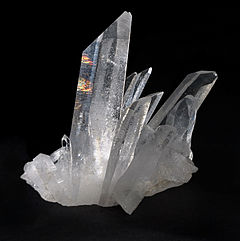 Pure quartz, traditionally called rock crystal (sometimes called clear quartz), is colourless, transparent, clear or translucent, and has often been used for hard stone carvings, such as the Lothair Crystal. Common coloured varieties include citrine, rose quartz, amethyst, smoky quartz, milky quartz, and others. Quartz goes by an array of different names. Quartz is the most common material identified as the mystical substance maban in Australian Aboriginal mythology. It is found regularly in passage tomb cemeteries in Europe in a burial context, such as Newgrange or Carrowmore in Ireland. The Irish word for quartz is grian cloch, which means 'stone of the sun'. Quartz was also used in Prehistoric Ireland, as well as many other countries, for stone tools; both vein quartz and rock crystal were knapped as part of the lithic technology of the prehistoric peoples. Pure quartz, traditionally called rock crystal (sometimes called clear quartz), is colourless, transparent, clear or translucent, and has often been used for hard stone carvings, such as the Lothair Crystal. Common coloured varieties include citrine, rose quartz, amethyst, smoky quartz, milky quartz, and others. Quartz goes by an array of different names. Quartz is the most common material identified as the mystical substance maban in Australian Aboriginal mythology. It is found regularly in passage tomb cemeteries in Europe in a burial context, such as Newgrange or Carrowmore in Ireland. The Irish word for quartz is grian cloch, which means 'stone of the sun'. Quartz was also used in Prehistoric Ireland, as well as many other countries, for stone tools; both vein quartz and rock crystal were knapped as part of the lithic technology of the prehistoric peoples.
|
|
|
|
|
May
|
Emerald:-
|
|
|
 Emeralds, like all coloured gemstones, are graded using four basic parameters Äthe four Cs :- Colour, Cut, Clarity and Carat weight. Before the 20th century, jewellers used the term water, as in "a gem of the finest water, to express the combination of two qualities: colour and clarity. Normally, in the grading of coloured gemstones, colour is by far the most important criterion. However, in the grading of emeralds, crystal is considered a close second. Both are necessary conditions. A fine emerald must possess not only a pure verdant green hue but also a high degree of transparency to be considered a top gem. In the 1960s, the American jewellery industry changed the definition of "emerald" to include the green vanadium-bearing beryl as emerald. As a result, vanadium emeralds purchased as emeralds in the United States are not recognised as such in the UK and Europe. In America, the distinction between traditional emeralds and the new vanadium kind is often reflected in the use of terms such as "Colombian Emerald". The colour of an emerald is divided into three components, hue, saturation and tone. Emeralds in antiquity have been mined in Egypt since 1500 BC, and India, and Austria since at least the 14th century. Colombia is by far the world's largest producer of emeralds, constituting 50-95% of the world production, with the number depending on the year, source and grade. Zambia is the world's second biggest producer, with its Kafubu River area deposits (Kagem Mines) about 45 km Southwest of Kitwe responsible for 20% of the world's production of gem quality stones in 2004. In the first half of 2011 the Kagem mines produced 3.74 tons of emeralds. Emeralds are found all over the world. Emeralds, like all coloured gemstones, are graded using four basic parameters Äthe four Cs :- Colour, Cut, Clarity and Carat weight. Before the 20th century, jewellers used the term water, as in "a gem of the finest water, to express the combination of two qualities: colour and clarity. Normally, in the grading of coloured gemstones, colour is by far the most important criterion. However, in the grading of emeralds, crystal is considered a close second. Both are necessary conditions. A fine emerald must possess not only a pure verdant green hue but also a high degree of transparency to be considered a top gem. In the 1960s, the American jewellery industry changed the definition of "emerald" to include the green vanadium-bearing beryl as emerald. As a result, vanadium emeralds purchased as emeralds in the United States are not recognised as such in the UK and Europe. In America, the distinction between traditional emeralds and the new vanadium kind is often reflected in the use of terms such as "Colombian Emerald". The colour of an emerald is divided into three components, hue, saturation and tone. Emeralds in antiquity have been mined in Egypt since 1500 BC, and India, and Austria since at least the 14th century. Colombia is by far the world's largest producer of emeralds, constituting 50-95% of the world production, with the number depending on the year, source and grade. Zambia is the world's second biggest producer, with its Kafubu River area deposits (Kagem Mines) about 45 km Southwest of Kitwe responsible for 20% of the world's production of gem quality stones in 2004. In the first half of 2011 the Kagem mines produced 3.74 tons of emeralds. Emeralds are found all over the world.
|
|
|
|
|
|
Chrysoprase:-
|
|
|
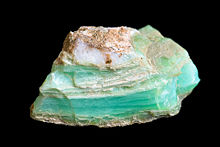 Chrysoprase, chrysophrase or chrysoprasus is a gemstone variety of chalcedony (a cryptocrystalline form of silica) that contains small quantities of nickel. Its colour is normally apple-green, but varies to deep green. Unlike emerald which owes its green colour to the presence of chromium, the colour of chrysoprase is due to trace amounts of nickel compounds in the Chrysoprase, chrysophrase or chrysoprasus is a gemstone variety of chalcedony (a cryptocrystalline form of silica) that contains small quantities of nickel. Its colour is normally apple-green, but varies to deep green. Unlike emerald which owes its green colour to the presence of chromium, the colour of chrysoprase is due to trace amounts of nickel compounds in the 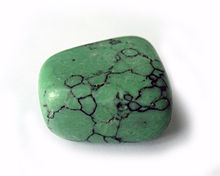 form of very small inclusions. form of very small inclusions.
The best known sources of chrysoprase are Queensland, Western Australia, Germany, Poland, Russia, Arizona, California, and Brazil. The chrysoprase and Ni silicate ore deposit in Szklary, Lower Silesia, Poland, was probably the biggest European chrysoprase occurrence and possibly also the biggest in the world. The image on right shows the polished stone..
|
|
|
|
|
June
|
Pearl:-
|
|
|
 A pearl is a hard object produced within the soft tissue of a living shelled mollusc. Just like the shell of a clam, a pearl is made up of calcium carbonate in minute crystalline form, which has been deposited in concentric layers. The ideal pearl is perfectly round and smooth, but many other shapes of pearls (baroque pearls) occur. The finest quality natural pearls have been highly valued as gemstones and objects of beauty for many centuries, and because of this, the word pearl has become a metaphor for something very rare, fine, admirable, and valuable. Whether wild or cultured, gem quality pearls are almost always nacreous and iridescent, as is the interior of the shell that produces them. However, almost all species of shelled molluscs are capable of producing pearls (formally referred to as "calcareous concretions" by some sources) of lesser shine or less spherical shape. Although these may also be legitimately referred to as "pearls" by geological labs and are formed in the same way, most of them have no value, except as curiosities. Freshwater and saltwater pearls may sometimes look quite similar, but they come from different sources. Freshwater pearls form in various species of freshwater mussels, family Unionidae, which live in lakes, rivers, ponds and other bodies of fresh water. These freshwater pearl mussels occur not only in hotter climates, but also in colder more temperate areas such as Scotland (where they are protected under law). Most freshwater cultured pearls are sold today come from China. Saltwater pearls grow within pearl oysters, family Pteriidae, which live in oceans. Saltwater pearl oysters are usually cultivated in protected lagoons or volcanic atolls. The value of the pearls in jewellery is determined by a combination of the lustre, colour, size, lack of surface flaw and symmetry that are appropriate for the type of pearl under consideration. Among those attributes, lustre is the most important differentiator of pearl quality according to jewellers. All factors being equal, however, the larger the pearl the more valuable it is. Large, perfectly round pearls are rare and highly valued. Teardrop-shaped pearls are often used in pendants. A pearl is a hard object produced within the soft tissue of a living shelled mollusc. Just like the shell of a clam, a pearl is made up of calcium carbonate in minute crystalline form, which has been deposited in concentric layers. The ideal pearl is perfectly round and smooth, but many other shapes of pearls (baroque pearls) occur. The finest quality natural pearls have been highly valued as gemstones and objects of beauty for many centuries, and because of this, the word pearl has become a metaphor for something very rare, fine, admirable, and valuable. Whether wild or cultured, gem quality pearls are almost always nacreous and iridescent, as is the interior of the shell that produces them. However, almost all species of shelled molluscs are capable of producing pearls (formally referred to as "calcareous concretions" by some sources) of lesser shine or less spherical shape. Although these may also be legitimately referred to as "pearls" by geological labs and are formed in the same way, most of them have no value, except as curiosities. Freshwater and saltwater pearls may sometimes look quite similar, but they come from different sources. Freshwater pearls form in various species of freshwater mussels, family Unionidae, which live in lakes, rivers, ponds and other bodies of fresh water. These freshwater pearl mussels occur not only in hotter climates, but also in colder more temperate areas such as Scotland (where they are protected under law). Most freshwater cultured pearls are sold today come from China. Saltwater pearls grow within pearl oysters, family Pteriidae, which live in oceans. Saltwater pearl oysters are usually cultivated in protected lagoons or volcanic atolls. The value of the pearls in jewellery is determined by a combination of the lustre, colour, size, lack of surface flaw and symmetry that are appropriate for the type of pearl under consideration. Among those attributes, lustre is the most important differentiator of pearl quality according to jewellers. All factors being equal, however, the larger the pearl the more valuable it is. Large, perfectly round pearls are rare and highly valued. Teardrop-shaped pearls are often used in pendants.
|
|
|
|
|
|
Moonstone:-
|
|
|
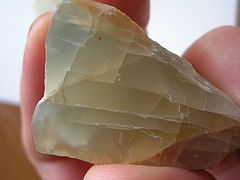 Moonstone has been used in jewellery for centuries, including ancient civilisations. The Romans admired moonstone, as they believed it was born from solidified rays of the moon. Both the Romans and Greeks associated Moonstone with their lunar gods and goddesses. Moonstone is composed of two feldspar species, orthoclase and albite. The two species are intermingled. Then, as the newly formed mineral cools, the inter growth of orthoclase and albite separates into stacked, alternating layers. When light falls between these thin, flat layers, it scatters in many directions producing the phenomenon called adularescence. Deposits of moonstone occur in Australia, the Austrian Alps, Mexico, Madagascar, Burma, Norway, Poland , India, Sri Lanka and the United States. It is currently the state gem for Florida. Moonstone has been used in jewellery for centuries, including ancient civilisations. The Romans admired moonstone, as they believed it was born from solidified rays of the moon. Both the Romans and Greeks associated Moonstone with their lunar gods and goddesses. Moonstone is composed of two feldspar species, orthoclase and albite. The two species are intermingled. Then, as the newly formed mineral cools, the inter growth of orthoclase and albite separates into stacked, alternating layers. When light falls between these thin, flat layers, it scatters in many directions producing the phenomenon called adularescence. Deposits of moonstone occur in Australia, the Austrian Alps, Mexico, Madagascar, Burma, Norway, Poland , India, Sri Lanka and the United States. It is currently the state gem for Florida.
|
|
|
|
|
July
|
Ruby:-
|
|
|
 A ruby is a pink to blood-red coloured gemstone, a variety of the mineral corundum (aluminium oxide). The red colour is caused mainly by the presence of the element chromium. Its name comes from ruber, Latin for red. Other varieties of gem-quality corundum are called sapphires. The ruby is considered one of the four precious stones, together with the sapphire, the emerald and the diamond. All natural rubies have imperfections in them, including colour impurities and inclusions of rutile needles known as "silk". Geologists use these needle inclusions found in natural rubies to distinguish them from synthetics, simulants, or substitutes. The Mogok Valley in Upper Myanmar (Burma) was for centuries the world's main source for rubies. That region has produced some of the finest rubies ever mined, but in recent years very few good rubies have been found there. The very best colour in Myanmar rubies is sometimes described as "pigeon's blood." In central Myanmar, the area of Mong Hsu began producing rubies during the 1990s and rapidly became the world's main ruby mining area. The most recently found ruby deposit in Myanmar is in Namya (Namyazeik) located in the northern state of Kachin. Rubies can be evaluated using the four Cs together with their size and geographic origin. In the evaluation of coloured gemstones, colour is the most important factor. Colour divides into three components, hue, saturation and tone. Hue refers to "colour" as we normally use the term. Transparent gemstones occur in the following primary hues: red, orange, yellow, green, blue, violet. The finest ruby is best described as being a vivid medium-dark toned red. Rubies have always been held in high esteem in Asian countries. They were used to ornament armour, scabbards, and harnesses of noblemen in India and China. Rubies were also laid beneath the foundation of buildings to secure good fortune to the structure. A ruby is a pink to blood-red coloured gemstone, a variety of the mineral corundum (aluminium oxide). The red colour is caused mainly by the presence of the element chromium. Its name comes from ruber, Latin for red. Other varieties of gem-quality corundum are called sapphires. The ruby is considered one of the four precious stones, together with the sapphire, the emerald and the diamond. All natural rubies have imperfections in them, including colour impurities and inclusions of rutile needles known as "silk". Geologists use these needle inclusions found in natural rubies to distinguish them from synthetics, simulants, or substitutes. The Mogok Valley in Upper Myanmar (Burma) was for centuries the world's main source for rubies. That region has produced some of the finest rubies ever mined, but in recent years very few good rubies have been found there. The very best colour in Myanmar rubies is sometimes described as "pigeon's blood." In central Myanmar, the area of Mong Hsu began producing rubies during the 1990s and rapidly became the world's main ruby mining area. The most recently found ruby deposit in Myanmar is in Namya (Namyazeik) located in the northern state of Kachin. Rubies can be evaluated using the four Cs together with their size and geographic origin. In the evaluation of coloured gemstones, colour is the most important factor. Colour divides into three components, hue, saturation and tone. Hue refers to "colour" as we normally use the term. Transparent gemstones occur in the following primary hues: red, orange, yellow, green, blue, violet. The finest ruby is best described as being a vivid medium-dark toned red. Rubies have always been held in high esteem in Asian countries. They were used to ornament armour, scabbards, and harnesses of noblemen in India and China. Rubies were also laid beneath the foundation of buildings to secure good fortune to the structure.
|
|
|
|
|
|
Carnelian:-
|
|
|
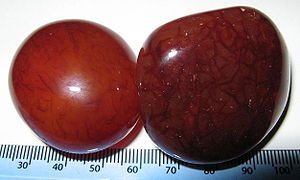 Carnelian (also spelt cornelian) is a brownish-red mineral which is commonly used as a semi-precious gemstone. The bow drill was used to drill holes into carnelian in Mehrgarh between 4th-5th millennium BC. Carnelian was recovered from Bronze Age Minoan layers at Knossos on Crete in a form that demonstrated its use in decorative arts; this use dates to approximately 1800 BC. Carnelian was used widely during Roman times to make engraved gems for signet or seal rings for imprinting a seal with wax on correspondence or other important documents. Hot wax does not stick to carnelian. Carnelian (also spelt cornelian) is a brownish-red mineral which is commonly used as a semi-precious gemstone. The bow drill was used to drill holes into carnelian in Mehrgarh between 4th-5th millennium BC. Carnelian was recovered from Bronze Age Minoan layers at Knossos on Crete in a form that demonstrated its use in decorative arts; this use dates to approximately 1800 BC. Carnelian was used widely during Roman times to make engraved gems for signet or seal rings for imprinting a seal with wax on correspondence or other important documents. Hot wax does not stick to carnelian.
|
|
|
|
|
August
|
Peridot:-
|
|
|
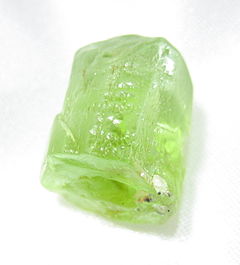 The origin of the name peridot is uncertain. The Oxford English Dictionary suggests an alteration of Anglo Norman pedoret (classical Latin paederot), a kind of opal, rather than the Arabic word faridat, meaning "gem". Peridot is one of the few gemstones that occur in only one colour, an olive green. The intensity and tint of the green, however, depends on how much iron is contained in the crystal structure, so the colour of individual peridot gems can vary from yellow to olive, to brownish-green. The most valued colour is a dark olive-green. Olivine, of which peridot is a type, is a common mineral in mafic and ultramafic rocks, and it is often found in lavas and in peridotite xenoliths of the mantle, which lavas carry to the surface; but gem quality peridot only occurs in a fraction of these settings. Peridot can be also found in meteorites. It is sometimes mistaken for emeralds and other green gems. The origin of the name peridot is uncertain. The Oxford English Dictionary suggests an alteration of Anglo Norman pedoret (classical Latin paederot), a kind of opal, rather than the Arabic word faridat, meaning "gem". Peridot is one of the few gemstones that occur in only one colour, an olive green. The intensity and tint of the green, however, depends on how much iron is contained in the crystal structure, so the colour of individual peridot gems can vary from yellow to olive, to brownish-green. The most valued colour is a dark olive-green. Olivine, of which peridot is a type, is a common mineral in mafic and ultramafic rocks, and it is often found in lavas and in peridotite xenoliths of the mantle, which lavas carry to the surface; but gem quality peridot only occurs in a fraction of these settings. Peridot can be also found in meteorites. It is sometimes mistaken for emeralds and other green gems.
|
|
|
|
|
|
Sardonyx:-
|
|
|
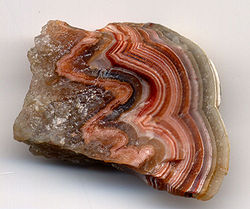 Sardonyx is a variant in which the coloured bands are sard (shades of red) rather than black. Black onyx is perhaps the most famous variety, but is not as common as onyx with coloured bands. Artificial treatments have been used since ancient times to produce both the black colour in "black onyx" and the reds and yellows in sardonyx. Most "black onyx" on the market is artificially coloured. Onyx was used in Egypt as early as the Second Dynasty to make bowls and other pottery items. Use of sardonyx appears in the art of Minoan Crete, notably from the archaeological recoveries at Knossos. Onyx is also mentioned in the Bible at various points, such as in Genesis 2:12 "and the gold of that land is good: there is bdellium and the onyx stone", and such as the priests' garments and the foundation of the city of Heaven in Revelation. Sardonyx is a variant in which the coloured bands are sard (shades of red) rather than black. Black onyx is perhaps the most famous variety, but is not as common as onyx with coloured bands. Artificial treatments have been used since ancient times to produce both the black colour in "black onyx" and the reds and yellows in sardonyx. Most "black onyx" on the market is artificially coloured. Onyx was used in Egypt as early as the Second Dynasty to make bowls and other pottery items. Use of sardonyx appears in the art of Minoan Crete, notably from the archaeological recoveries at Knossos. Onyx is also mentioned in the Bible at various points, such as in Genesis 2:12 "and the gold of that land is good: there is bdellium and the onyx stone", and such as the priests' garments and the foundation of the city of Heaven in Revelation.
|
|
|
|
|
September
|
Sapphire:-
|
|
|
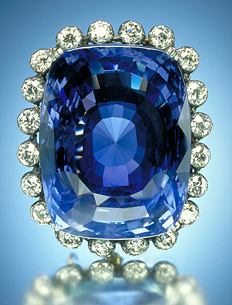 Commonly, sapphires are worn in jewellery. Sapphires may be found naturally, by searching through certain sediments (due to their resistance to being eroded compared to softer stones) or rock formations. The sapphire is one of the three gem-varieties of corundum, the other two being ruby, defined as corundum in a shade of red and padparadscha a pinkish orange variety. Although blue is their most well-known colour, sapphires may also be colourless and they are found in many colours including shades of grey and black. Colour in gemstones breaks down into three components, hue, saturation, and tone. Hue is most commonly understood as the "colour" of the gemstone. Saturation refers to the vividness or brightness of the hue, and tone is the lightness to darkness of the hue. Blue sapphire exists in various mixtures of its primary (blue) and secondary hues, various tonal levels (shades) and at various levels of saturation (vividness). Yellow and green sapphires are also commonly found. Pink sapphires deepen in colour as the quantity of chromium increases. The deeper the pink colour the higher their monetary value, as long as the colour is tending toward the red of rubies. Sapphires also occur in shades of orange and brown. Colourless sapphires are sometimes used as diamond substitutes in jewellery. Natural padparadscha (pinkish orange) sapphires often draw higher prices than many of even the finest blue sapphires. Recently, more sapphires of this colour have appeared on the market as a result of a new artificial treatment method that is called "lattice diffusion". A rare variety of natural sapphire, known as colour-change sapphire, exhibits different colours in different light. Colour change sapphires are blue in outdoor light and purple under incandescent indoor light, or green to grey-green in daylight and pink to reddish-violet in incandescent light. The sapphire is the traditional gift for a 65th Wedding anniversary. Commonly, sapphires are worn in jewellery. Sapphires may be found naturally, by searching through certain sediments (due to their resistance to being eroded compared to softer stones) or rock formations. The sapphire is one of the three gem-varieties of corundum, the other two being ruby, defined as corundum in a shade of red and padparadscha a pinkish orange variety. Although blue is their most well-known colour, sapphires may also be colourless and they are found in many colours including shades of grey and black. Colour in gemstones breaks down into three components, hue, saturation, and tone. Hue is most commonly understood as the "colour" of the gemstone. Saturation refers to the vividness or brightness of the hue, and tone is the lightness to darkness of the hue. Blue sapphire exists in various mixtures of its primary (blue) and secondary hues, various tonal levels (shades) and at various levels of saturation (vividness). Yellow and green sapphires are also commonly found. Pink sapphires deepen in colour as the quantity of chromium increases. The deeper the pink colour the higher their monetary value, as long as the colour is tending toward the red of rubies. Sapphires also occur in shades of orange and brown. Colourless sapphires are sometimes used as diamond substitutes in jewellery. Natural padparadscha (pinkish orange) sapphires often draw higher prices than many of even the finest blue sapphires. Recently, more sapphires of this colour have appeared on the market as a result of a new artificial treatment method that is called "lattice diffusion". A rare variety of natural sapphire, known as colour-change sapphire, exhibits different colours in different light. Colour change sapphires are blue in outdoor light and purple under incandescent indoor light, or green to grey-green in daylight and pink to reddish-violet in incandescent light. The sapphire is the traditional gift for a 65th Wedding anniversary.
|
|
|
|
|
|
Lapis Lazuli:-
|
|
|
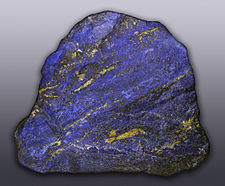 Lapis Lazuli is a deep blue semiprecious stone that has been prized since antiquity for its intense colour. At the end of the Middle Ages, lapis lazuli began to be exported to Europe, where it was ground into powder and made into ultramarine, the finest and most expensive of all blue pigments. It was used by the most important artists of the Renaissance and Baroque, including Masaccio, Perugino, Titian and Vermeer, and was often reserved for the clothing of the central figure of the painting, especially the Virgin Mary. Today mines in Northeast Afghanistan are still the major source of lapis lazuli. Important amounts are also produced from mines west of Lake Baika in Russia, and in the Andes mountains in Chile. Smaller quantities are mined in Italy, Mongolia, the United States and Canada. Lapis takes an excellent polish and can be made into jewellery, carvings, boxes, mosaics, ornaments, and vases. There are many references to sapphires in the Old Testament, but most scholars agree that, since sapphires were not known before the Roman Empire, they most likely are references to lapis lazuli. For instance, Exodus 24:10: "As they saw the God of Israel, and there was under his feet as it were a paved work of a sapphire stone.." (KJV). The term used in the Latin Vulgate Bible in this citation is "lapidus sapphiri," the term for lapis lazuli. Lapis Lazuli is a deep blue semiprecious stone that has been prized since antiquity for its intense colour. At the end of the Middle Ages, lapis lazuli began to be exported to Europe, where it was ground into powder and made into ultramarine, the finest and most expensive of all blue pigments. It was used by the most important artists of the Renaissance and Baroque, including Masaccio, Perugino, Titian and Vermeer, and was often reserved for the clothing of the central figure of the painting, especially the Virgin Mary. Today mines in Northeast Afghanistan are still the major source of lapis lazuli. Important amounts are also produced from mines west of Lake Baika in Russia, and in the Andes mountains in Chile. Smaller quantities are mined in Italy, Mongolia, the United States and Canada. Lapis takes an excellent polish and can be made into jewellery, carvings, boxes, mosaics, ornaments, and vases. There are many references to sapphires in the Old Testament, but most scholars agree that, since sapphires were not known before the Roman Empire, they most likely are references to lapis lazuli. For instance, Exodus 24:10: "As they saw the God of Israel, and there was under his feet as it were a paved work of a sapphire stone.." (KJV). The term used in the Latin Vulgate Bible in this citation is "lapidus sapphiri," the term for lapis lazuli.
|
|
|
|
|
October
|
Opal
|
|
|
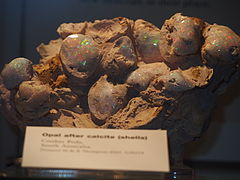 The internal structure of precious opal makes it diffract light; depending on the conditions in which it formed, it can take on many colours. Precious opal ranges from clear through white, grey, red, orange, yellow, green, blue, magenta, rose, pink, slate, olive, brown, and black. Of these hues, the reds against black are the most rare, whereas white and greens are the most common. It varies in optical density from opaque to semi-transparent. Common opal, called "potch" by miners, does not show the display of colour exhibited in precious opal. Besides the gemstone varieties that show a play of colour, there are other kinds of common opal such as the milk opal, milky bluish to greenish (which can sometimes be of gemstone quality). other variaties are:- Fire opal is a transparent to translucent opal, with warm body colours of yellow, orange, orange-yellow or red. It does not usually show any play of colour, although occasionally a stone will exhibit bright green flashes. These opals are commonly called Mexican fire opals. Girasol opal is a term sometimes mistakenly and improperly used to refer to fire opals as well as a type of transparent to semi-transparent type milky quartz from Madagascar which displays an asterism, or star effect, when cut properly. Peruvian opal (also called blue opal) is a semi-opaque to opaque blue-green stone found in Peru which is often cut to include the matrix in the more opaque stones. Australia produces around 97% of the world's opal. 90% is called 'light opal' or white and crystal opal. White makes up 60% of the opal productions but cannot be found in all of the opal fields. Crystal opal or pure hydrated silica makes up 30% of the opal produced, 8% is black and only 2% is boulder opal. In the Middle Ages, opal was considered a stone that could provide great luck because it was believed to possess all the virtues of each gemstone whose colour was represented in the colour spectrum of the opal. It was also said to confer the power of invisibility if wrapped in a fresh bay leaf and held in the hand. The internal structure of precious opal makes it diffract light; depending on the conditions in which it formed, it can take on many colours. Precious opal ranges from clear through white, grey, red, orange, yellow, green, blue, magenta, rose, pink, slate, olive, brown, and black. Of these hues, the reds against black are the most rare, whereas white and greens are the most common. It varies in optical density from opaque to semi-transparent. Common opal, called "potch" by miners, does not show the display of colour exhibited in precious opal. Besides the gemstone varieties that show a play of colour, there are other kinds of common opal such as the milk opal, milky bluish to greenish (which can sometimes be of gemstone quality). other variaties are:- Fire opal is a transparent to translucent opal, with warm body colours of yellow, orange, orange-yellow or red. It does not usually show any play of colour, although occasionally a stone will exhibit bright green flashes. These opals are commonly called Mexican fire opals. Girasol opal is a term sometimes mistakenly and improperly used to refer to fire opals as well as a type of transparent to semi-transparent type milky quartz from Madagascar which displays an asterism, or star effect, when cut properly. Peruvian opal (also called blue opal) is a semi-opaque to opaque blue-green stone found in Peru which is often cut to include the matrix in the more opaque stones. Australia produces around 97% of the world's opal. 90% is called 'light opal' or white and crystal opal. White makes up 60% of the opal productions but cannot be found in all of the opal fields. Crystal opal or pure hydrated silica makes up 30% of the opal produced, 8% is black and only 2% is boulder opal. In the Middle Ages, opal was considered a stone that could provide great luck because it was believed to possess all the virtues of each gemstone whose colour was represented in the colour spectrum of the opal. It was also said to confer the power of invisibility if wrapped in a fresh bay leaf and held in the hand.
|
|
|
|
|
November
|
Topaz:-
|
|
|
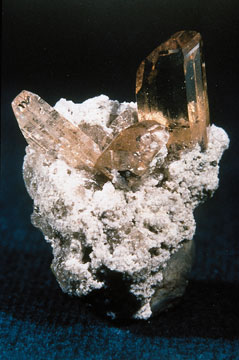 Pure topaz is colourless and transparent but is usually tinted by impurities; typical topaz is wine, yellow, pale grey, reddish-orange, or blue brown. It can also be made white, pale green, blue, gold, pink (rare), reddish-yellow or opaque to transparent/translucent. Topaz is commonly associated with silicic igneous rocks of the granite and rhyolite type. It typically crystallises in granitic pegmatites or in vapour cavities in rhyolite lava flows like those at Topaz Mountain in western Utah. It can be found with fluorite and cassiterite in various areas including the Ural and Ilmen mountains of Russia, in Afghanistan, Sri Lanka, Czech Republic, Germany, Norway, Pakistan, Italy, Sweden, Japan, Brazil, Mexico, Flinders Island, Australia, Nigeria and the United States. Many modern English translations of the Bible, including the King James Version mention topaz in Exodus 28:17 in reference to a stone in the Hoshen: "And thou shalt set in it settings of stones, even four rows of stones: the first row shall be a sardius, a topaz, and a carbuncle (garnet): this shall be the first row." Pure topaz is colourless and transparent but is usually tinted by impurities; typical topaz is wine, yellow, pale grey, reddish-orange, or blue brown. It can also be made white, pale green, blue, gold, pink (rare), reddish-yellow or opaque to transparent/translucent. Topaz is commonly associated with silicic igneous rocks of the granite and rhyolite type. It typically crystallises in granitic pegmatites or in vapour cavities in rhyolite lava flows like those at Topaz Mountain in western Utah. It can be found with fluorite and cassiterite in various areas including the Ural and Ilmen mountains of Russia, in Afghanistan, Sri Lanka, Czech Republic, Germany, Norway, Pakistan, Italy, Sweden, Japan, Brazil, Mexico, Flinders Island, Australia, Nigeria and the United States. Many modern English translations of the Bible, including the King James Version mention topaz in Exodus 28:17 in reference to a stone in the Hoshen: "And thou shalt set in it settings of stones, even four rows of stones: the first row shall be a sardius, a topaz, and a carbuncle (garnet): this shall be the first row."
|
|
|
|
|
|
Citrine:-
|
|
|
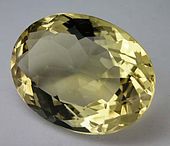 Citrine is a variety of quartz whose colour ranges from a pale yellow to brown. Natural citrines are rare; most commercial citrines are heat-treated amethysts or smoky quartzes. It is nearly impossible to tell cut citrine from yellow topaz visually, but they differ in hardness. Citrine has ferric impurities, and is rarely found naturally. Brazil is the leading producer of citrine, with much of its production coming from the state of Rio Grande do Sul. The name is derived from Latin citrina which means "yellow" and is also the origin of the word "citron." Sometimes citrine and amethyst can be found together in the same crystal, which is then referred to as ametrine. Citrine is a variety of quartz whose colour ranges from a pale yellow to brown. Natural citrines are rare; most commercial citrines are heat-treated amethysts or smoky quartzes. It is nearly impossible to tell cut citrine from yellow topaz visually, but they differ in hardness. Citrine has ferric impurities, and is rarely found naturally. Brazil is the leading producer of citrine, with much of its production coming from the state of Rio Grande do Sul. The name is derived from Latin citrina which means "yellow" and is also the origin of the word "citron." Sometimes citrine and amethyst can be found together in the same crystal, which is then referred to as ametrine.
|
|
|
|
|
December
|
Tanzanite:-
|
|
|
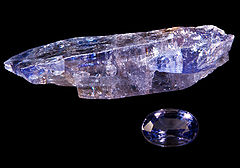 Tanzanite is noted for its remarkably strong trichroism, appearing alternately sapphire blue, violet and burgundy depending on crystal orientation. Tanzanite can also appear differently when viewed under alternate lighting conditions. The blues appear more evident when subjected to fluorescent light and the violet hues can be seen readily when viewed under incandescent illumination. Tanzanite is usually a reddish brown in its rough state, requiring artificial heat treatment to bring out the blue violet of the stone. The mineral was named by Tiffany & Co. after Tanzania, the country in which it was discovered. Emmanuel Merishiek Mollel, a Maasai tailor and part-time gold prospector living in Arusha (Tanzania), found transparent fragments of vivid blue and blue-purple gem crystals on a ridge near Mererani, some 40 km Southeast of Arusha. He decided that the mineral was olivine (peridot) but quickly realised that it was not, so he took to calling it "dumortierite", a blue non-gem mineral. Scientifically called "blue zoisite" , the gemstone was renamed as tanzanite by Tiffany & Co., who wanted to capitalize on the rarity and single location of the gem, but who thought that "blue zoisite" (which might be pronounced like "blue suicide") wouldn't sell well. Tiffanys original campaign advertised that tanzanite could now be found in two places "in Tanzania and at Tiffany's". The normal primary and secondary hues in tanzanite are blue and violet. Tanzanite is a trichroic gemstone, meaning that light that enters the stone is divided into three sections, each containing a portion of the visible spectrum. After heating, tanzanite becomes dichroic. The dichroic colors are purple and blue. The hue range of tanzanite is blue-purple to purple-blue. Tanzanite is noted for its remarkably strong trichroism, appearing alternately sapphire blue, violet and burgundy depending on crystal orientation. Tanzanite can also appear differently when viewed under alternate lighting conditions. The blues appear more evident when subjected to fluorescent light and the violet hues can be seen readily when viewed under incandescent illumination. Tanzanite is usually a reddish brown in its rough state, requiring artificial heat treatment to bring out the blue violet of the stone. The mineral was named by Tiffany & Co. after Tanzania, the country in which it was discovered. Emmanuel Merishiek Mollel, a Maasai tailor and part-time gold prospector living in Arusha (Tanzania), found transparent fragments of vivid blue and blue-purple gem crystals on a ridge near Mererani, some 40 km Southeast of Arusha. He decided that the mineral was olivine (peridot) but quickly realised that it was not, so he took to calling it "dumortierite", a blue non-gem mineral. Scientifically called "blue zoisite" , the gemstone was renamed as tanzanite by Tiffany & Co., who wanted to capitalize on the rarity and single location of the gem, but who thought that "blue zoisite" (which might be pronounced like "blue suicide") wouldn't sell well. Tiffanys original campaign advertised that tanzanite could now be found in two places "in Tanzania and at Tiffany's". The normal primary and secondary hues in tanzanite are blue and violet. Tanzanite is a trichroic gemstone, meaning that light that enters the stone is divided into three sections, each containing a portion of the visible spectrum. After heating, tanzanite becomes dichroic. The dichroic colors are purple and blue. The hue range of tanzanite is blue-purple to purple-blue.
|
|
|
|
|
|
Turquoise:-
|
|
|
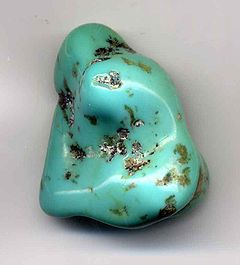 Turquoise has been known by many names, but the word turquoise, which dates to the 16th century, is derived from an Old French word for "Turkish", because the mineral was first brought to Europe from Turkey, from the mines in historical Khorasan Province of Iran. Pliny the Elder referred to the mineral as callais, the Iranians named it "phirouzeh" and the Aztecs knew it as Teoxihuitl. Turquoise was among the first gems to be mined, and while many historic sites have been depleted, some are still worked to this day. These are all small-scale, often seasonal operations, owing to the limited scope and remoteness of the deposits. Most are worked by hand with little or no mechanisation. However, turquoise is often recovered as a by product of large-scale copper mining operations. For at least 2,000 years, Iran, known before as Persia, has remained an important source of turquoise which was named by Iranians initially "pirouzeh" meaning "victory" and later after Arab invasion "firouzeh". In Iranian architecture, the blue turquoise was used to cover the domes of the Iranian palaces because its intense blue colour was also a symbol of heaven on earth. Turquoise has been known by many names, but the word turquoise, which dates to the 16th century, is derived from an Old French word for "Turkish", because the mineral was first brought to Europe from Turkey, from the mines in historical Khorasan Province of Iran. Pliny the Elder referred to the mineral as callais, the Iranians named it "phirouzeh" and the Aztecs knew it as Teoxihuitl. Turquoise was among the first gems to be mined, and while many historic sites have been depleted, some are still worked to this day. These are all small-scale, often seasonal operations, owing to the limited scope and remoteness of the deposits. Most are worked by hand with little or no mechanisation. However, turquoise is often recovered as a by product of large-scale copper mining operations. For at least 2,000 years, Iran, known before as Persia, has remained an important source of turquoise which was named by Iranians initially "pirouzeh" meaning "victory" and later after Arab invasion "firouzeh". In Iranian architecture, the blue turquoise was used to cover the domes of the Iranian palaces because its intense blue colour was also a symbol of heaven on earth.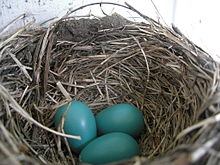 Hardness and richness of colour are two of the major factors in determining the value of turquoise; while colour is a matter of individual taste, generally speaking, the most desirable is a strong sky to "robin's egg" blue (in reference to the eggs of the American Robin). Whatever the colour, turquoise should not be excessively soft or chalky; even if treated, such lesser material (to which most turquoise belongs) is liable to fade or discolour over time and will not hold up to normal use in jewellery. Hardness and richness of colour are two of the major factors in determining the value of turquoise; while colour is a matter of individual taste, generally speaking, the most desirable is a strong sky to "robin's egg" blue (in reference to the eggs of the American Robin). Whatever the colour, turquoise should not be excessively soft or chalky; even if treated, such lesser material (to which most turquoise belongs) is liable to fade or discolour over time and will not hold up to normal use in jewellery.
|
|
|
|
|